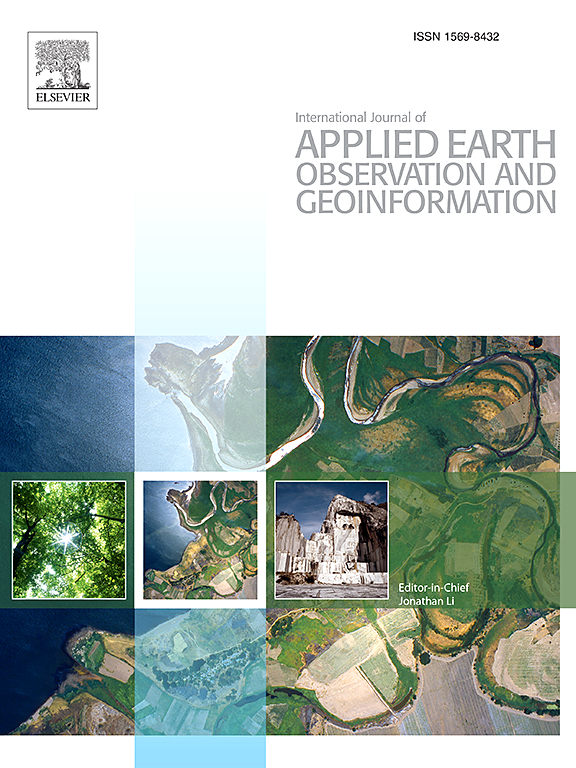Quantifying the functional composition and potential resilience hotspots across a large latitudinal and environmental gradient in South American forests
IF 8.6
Q1 REMOTE SENSING
International journal of applied earth observation and geoinformation : ITC journal
Pub Date : 2025-07-01
DOI:10.1016/j.jag.2025.104704
引用次数: 0
Abstract
Accurately inferring plant functional trait composition, diversity, and redundancy across space and time is pivotal for understanding environmental change impacts on forests’ biodiversity and functioning. Here, we tested the capabilities of combining in-situ and remote sensing approaches to deliver accurate estimates of functional trait composition, diversity, and redundancy of temperate forest vegetation in South America (30°S to 53°S) considering leaf and stem morphological, nutrient, hydraulic, and photosynthetic traits. We identified hydrological stress, soil properties, and topography as key drivers of plant functional trait distribution and variation. Further, hydrological stress and soil properties were key determinants of functional diversity and redundancy across a large latitudinal gradient. Functional diversity peaked across Mediterranean forests, occupying between 30°S to 35°S. Functional diversity and redundancy were both high at latitudes between 35°S and 42°S, coinciding with Valdivian rainforests. Conversely, functional redundancy peaked between 42°S and 48°S, corresponding to Austral forests. Towards the southernmost extent of the study area, functional diversity and redundancy were both low between 48°S and 53°S, corresponding to the Magellanic subpolar forests. Our results highlight areas in South American temperate forests where both plant functional diversity and redundancy were maximal, hence potentially pointing towards areas more resilient to environmental change.
在大的纬度和环境梯度上量化南美森林的功能组成和潜在的恢复热点
准确推断植物功能性状的组成、多样性和冗余度是理解环境变化对森林生物多样性和功能影响的关键。在这里,我们测试了原位和遥感方法相结合的能力,以提供准确的估计功能性状组成,多样性和冗余的温带森林植被在南美洲(30°S至53°S)考虑叶和茎形态,营养,水力和光合性状。我们确定了水文胁迫、土壤性质和地形是植物功能性状分布和变化的关键驱动因素。此外,水文应力和土壤性质是跨大纬度梯度的功能多样性和冗余的关键决定因素。功能多样性在地中海森林中达到顶峰,分布在南纬30°至35°之间。在35°S和42°S之间的纬度,功能多样性和冗余度都很高,与瓦尔迪维亚雨林相一致。相反,功能冗余在42°S和48°S之间达到峰值,与南方森林相对应。在研究区最南端的48°S和53°S之间,功能多样性和冗余度都很低,与麦哲伦亚极地森林相对应。我们的研究结果突出了南美洲温带森林中植物功能多样性和冗余度最大的地区,因此可能指向对环境变化更具弹性的地区。
本文章由计算机程序翻译,如有差异,请以英文原文为准。
求助全文
约1分钟内获得全文
求助全文
来源期刊

International journal of applied earth observation and geoinformation : ITC journal
Global and Planetary Change, Management, Monitoring, Policy and Law, Earth-Surface Processes, Computers in Earth Sciences
CiteScore
12.00
自引率
0.00%
发文量
0
审稿时长
77 days
期刊介绍:
The International Journal of Applied Earth Observation and Geoinformation publishes original papers that utilize earth observation data for natural resource and environmental inventory and management. These data primarily originate from remote sensing platforms, including satellites and aircraft, supplemented by surface and subsurface measurements. Addressing natural resources such as forests, agricultural land, soils, and water, as well as environmental concerns like biodiversity, land degradation, and hazards, the journal explores conceptual and data-driven approaches. It covers geoinformation themes like capturing, databasing, visualization, interpretation, data quality, and spatial uncertainty.
 求助内容:
求助内容: 应助结果提醒方式:
应助结果提醒方式:


